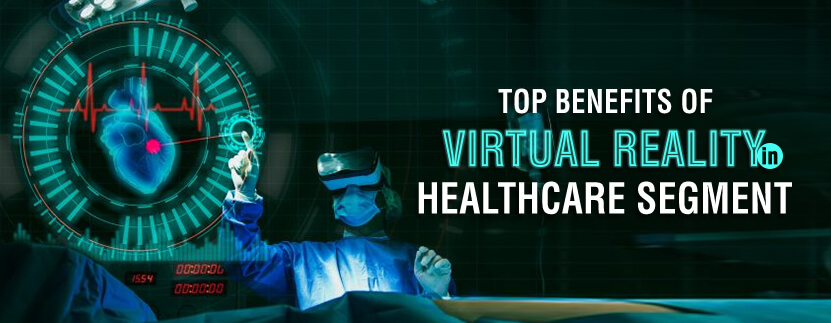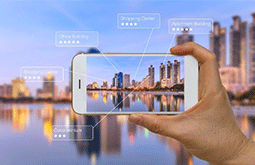Top Benefits of Virtual Reality in Healthcare Segment
VR, or Virtual Reality, is more than just building engaging games. Among its several benefits, its influence on healthcare is perhaps the most notable. Leveraging VR technology, medical practitioners can use advanced tools for accurate diagnoses.
Diagnosing complex ailments becomes much easier with VR due to scanned holographic images. These 2D scanned images create holograms that give an accurate perspective of the human anatomy. Probing inside the complex human body virtually while treating patients helps with better diagnosis. Thus, VR is being increasingly used in the healthcare vertical, improving the healthcare experience.
In many ways, virtual reality applications in medicine are more effective and efficient. The medical fields benefiting from VR intervention are discussed below.

Post-Traumatic Stress Disorder (PTSD)
War veterans mostly suffer from PTSD compared to civilians. To help them get over the traumatic stress associated with warfare, VR simulations of war scenes are made. The veterans virtually relive the events of the war in a safe and controlled atmosphere.
With each traumatic experience that compels them to behave violently, patients confront them virtually. Soon after, the therapist talks to them and counsels them to overcome the fear. Clinical methods are suggested to deal with the stress; novel methods such as virtual gaming are used. All these help combat veterans channel their aggressive energy through constructive means.
Practicing Surgical Methods
Junior surgeons often accompany their senior counterparts in operation theaters to assist them. This is also done to help the junior doctors understand how surgical tools have to be used on patients. As well as how the surgical machineries are used, which tools to use, which to avoid, and so on.
Any inept step on their part can subject the patient’s life to the threat. With VR technology, aspiring surgeons can hone their skills in simulated conditions with 3D dummy patient models. The immersive experience closely resembles actual OT conditions, and skills can be perfected with ease.
Devising Effective Ways for Treating Brain Damage
VR is being used progressively to identify the extent of damage a patient’s brain has suffered. This helps medical professionals and therapists devise proper remedies for faster recovery. For example, their cognitive abilities can be tested through a VR-simulated experience.
In these virtual environments, patients need to find their way out of a building through doors of various colors or a maze-like structure. The faster the patient finds their way out, the more we can tell about the extent of their brain damage.
Curing Anxiety
For treating anxiety symptoms, meditation and breath control have proven highly effective. Virtual simulation can benefit in this aspect too by curing someone's anxiety. The technology is being leveraged through the ‘Deep’ app, playable on the Oculus Rift gadget.
In this app, the controls are tuned to the proper meditative breathing of the user. The gadget has a band that is fastened around the patient's chest to measure the breathing rate. By analyzing the breathing rhythm, the therapist can offer apt counseling. As well, this helps the patient control their anxiety and symptoms of panic attacks.
Training Paramedical Staff
Lifesaving skills can be imparted to paramedics without risking anyone's life. Virtual simulations are used that can replicate real-world emergencies and accidental situations. These highly realistic simulations train paramedics to find ways of handling them tactically. They learn to keep calm and save civilians by responding to various critical situations.
Managing Pain
VR allows chronic pain management by letting patients navigate into the virtual world. Within a simulated, interactive virtual environment, the patient’s imagination is let loose. They start experiencing a virtual world of calmness and peace unknown to them before.
This distraction takes their focus away from the pain, making their immune system more adaptable. This is done to make them respond to the treatment course and medicines. The peace factor also facilitates serenity and calmness in patients by helping them meditate. As it is proven, meditation immensely helps individuals improve their concentration power.
Treating Mental Problems
VR helps psychotic patients relive their fears in a safe and controlled environment. In such virtually augmented environments, recovery therapies can be applied more effectively. One need not spend longer durations in rehab centers and waste their lives away.
Schizophrenic patients can interact socially with virtual peers and evolve into more sociable individuals. Those battling depression or chronic anxiety can deviate from tormenting trigger points. They can be transported to peaceful and rejuvenating virtual worlds through digital simulations.
Facilitating Rehabilitation
Rehab centers for chronic patients, state prisoners, addicts, etc., are greatly benefited. Physical therapy programs are made more effective with this tech innovation. Interactions with doctors and therapists are monitored with VR-powered wearables.
Patients' responses to the treatments are also supervised for further analysis. The content and context of these treatments can be significantly controlled with VR. The treatment programs can also be customized to replicate safety and homely warmth.
Rehab experts also get to learn about contemporary skills and test their expertise in safer environments. No actual patients are required for such practices and experiments.
Monitoring Emotive Quotient of Medical Staff
With VR driven software, healthcare practitioners can interact with 3D replicas of patients. The entire process happens within a virtual environment that replicates real-world individuals in distress. The way paramedic staff respond while offering treatment is monitored by different sensors.
These responses reveal their internal emotions. Based upon these analyses, training methods are devised for better emotion control.
Minimizing Invasive Diagnostic Procedures
Adapting VR technology can prevent invasive treatment methods from causing pain to patients. Instead, they can wear VR-driven wearables and sensors across various parts of their bodies. Doctors and medical practitioners can later evaluate the readings from these wearables.
These analyses, along with MRI scans and other reports, can give them a fair idea about the complications. Hence, there is no need for any invasive procedures.
Conducting Robotic Surgery
In robotic surgery, a bot conducts the surgery, and its methods are controlled by a surgeon. It saves time and minimizes complications. VR is being used to train surgeons on ways to better control the movement of bots.
Also, VR is facilitating tele-surgery where surgeons can operate from remote locations. The VR modules offer insights into the level of pressure to apply to bots during the procedures.
Applying VR in Various Medical Realms
VR is not only effective in the rehab, diagnostic, or surgical domains. It finds application in almost all realms of modern healthcare, like:
- Dentistry
- Nursing
- Therapeutic care
- Treatment of phobias
- Extending care for autism
- Managing health-related challenges
- Offering recuperative care for disabled
- and much more.
Medical care simulations help expedite treatment outcomes and make procedures safer. Along with replacing invasive surgeries and procedures, an accurate clinical diagnosis can be made.
The outcomes of these diagnoses can be compared with results of-
- X-Rays
- MRIs
- ECGs
- Blood tests, and,
- Scans
- to assess the actual reason for the complication. Thus, time-consuming and risky procedures are eliminated.
Conclusion
We have reached the end of this detailed article on the multiple benefits of VR in the healthcare sector. Hope by now you have got a fair idea of the technology and how it is transforming medical processes. Virtual reality, along with Augmented Reality is successfully leveraged to achieve accurate diagnosis, and prevent complex surgeries. As well as treat psychosis, phobias, traumas, and more.
Scanned 2D images are projected in holograms, enabling doctors to devise effective medical solutions. And, it is just the beginning. VR has great potential to radically change the face of healthcare practices.
Professional expert 3D modeling companies can develop VR-compatible custom 3D models. Contact such experts if you ever need any 3D medical models.



